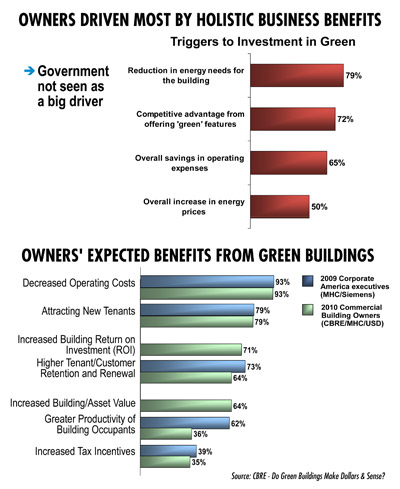|
FEATURE ARTICLE, MAY 2011
MEASURING SUSTAINABLE SATISFACTION
Going green grabs attention, but does it make sense for office properties?
Interview by Jaime Lackey
Clean energy, water conservation, reduced consumption — all forms of environmental responsibility are praised today. But business is still business, and office buildings need to operate in the black. Is it a good business decision for property owners to implement sustainable improvements and pursue green certifications?
In an effort to find out, CB Richard Ellis has surveyed owners, managers and tenants at 156 buildings that the company manages. The properties, which are located in 10 U.S. markets, total 52.5 million square feet and include 3,000 tenants. To see what CBRE’s second annual sustainability study revealed, Northeast Real Estate Business talked with David Pogue, national director of sustainability with CBRE.
NREB: Briefly, tell me about CBRE’s study, “Do Green Buildings Make Dollars & Sense?”
Pogue: It is a comprehensive look at how commercial building owners, managers, tenant firms and occupants perceive the benefits of green buildings. The study reveals bottom-line and human factor benefits that are driving green building growth in the U.S. market.
NREB: What is the one thing that property owners can take from the study?
Pogue: The findings show that sustainable buildings generate stronger investment fundamentals than traditionally managed competitor buildings and that occupants of green buildings tend to be more productive.
NREB: What are the main reasons property owners consider pursuing LEED or Energy Star certification? Are their efforts paying off?
Pogue: A primary reason is financial. Our research shows that owners of sustainably managed buildings anticipate a 4 percent higher return on investment, 5 percent increases on building value and occupancy and 1 percent rise in rental income. Our data actually indicates that sustainable buildings, on average, had occupancy rates that were nearly 3 percent higher than the general market and achieved a slightly higher rental rate.

NREB: What about the cost of sustainable upgrades? Are the upgrades worth the investment?
Pogue: We generally are seeking low-cost or no-cost improvements and have dozens of case studies where we have been able to significantly improve the performance of a building with limited capital expense. These efforts can include reducing hours of operation, especially Saturday hours; resetting temperature controls on both mechanical systems and boilers; replacing incandescent lighting with CFLs; installing motion detectors on lighting in conference rooms, restrooms, and all infrequently used spaces; and installing variable speed drives on electrical systems, such as ventilation systems and elevators.
The cost of LEED® for Existing Buildings certification is also lower than generally expected, averaging less than 25 cents per square foot.
NREB: What do tenants think about green buildings?
Pogue: Those who responded to our most recent study, which surveyed more than 550 tenants, indicated they care about the health impact of green buildings, including access to daylight and better indoor air quality. Eighty-three percent of tenants believed they have a healthier indoor environment as a result of green efforts.
NREB: What types of tenants are most interested in sustainable buildings? Why are these types of companies more interested?
Pogue: Our study continues to show that larger, publicly traded firms are the most interested. Other studies have shown that these firms are generally concerned about their customers’ and shareholders’ perception, and are increasingly competing for young and upcoming talent — and these employees often seek to join firms that embrace their own environmental values.
NREB: What do the results of your study mean for the people who are marketing office space?
Pogue: Sustainable practices may give your property an edge in a competitive leasing environment.
NREB: When does it not make sense for a property owner to pursue some form of green certification?
Pogue: There are still some markets that have not yet demonstrated a financial benefit to “go green.” Additionally, there are some buildings that are so out of date with mechanical and other infrastructure systems that the cost to pursue LEED certification, for example, could never be justified.
NREB: What is the future of LEED certification? Energy Star? Other sustainable measures in office properties?
Pogue: A recent study by real estate scholar Nils Kok shows that there has been a doubling of “sustainable space,” defined as either Energy Star labeled or LEED certified, during the past 2 years in the top 25 U.S. markets. That trend will certainly continue as more and more cities and states mandate green building codes or regulate and require energy usage disclosure. I can foresee the day when the traditional Class A building will also need to incorporate green features to maintain its market-leading status.
NREB: What are CBRE’s plans to further study this topic?
Pogue: We are already beginning work to present a third year of research findings, and the U.S. Green Building Council recently requested that we present these findings at Greenbuild 2011. This year our work will again focus on CBRE’s managed portfolio of sustainable buildings. Additionally, we are looking to add the review of corporate facilities as well.
©2010 France Publications, Inc. Duplication
or reproduction of this article not permitted without authorization
from France Publications, Inc. For information on reprints
of this article contact Barbara
Sherer at (630) 554-6054.
|
